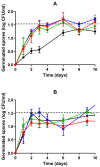Influence of Sporulation Temperature on Germination and Growth of B. weihenstephanensis Strains in Specific Nutrients and in an Extended Shelf-Life Refrigerated Matrix Under Commercial Pasteurization and Storage Conditions
- PMID: 39517218
- PMCID: PMC11545089
- DOI: 10.3390/foods13213434
Influence of Sporulation Temperature on Germination and Growth of B. weihenstephanensis Strains in Specific Nutrients and in an Extended Shelf-Life Refrigerated Matrix Under Commercial Pasteurization and Storage Conditions
Abstract
Extended shelf-life (ESL) refrigerated ready-to-eat foods are thermally pasteurized to ensure food safety and stability. However, surviving psychrotrophic Bacillus cereus spores can still pose a challenge. Studies predicting their behavior often overlook sporulation conditions. This study investigated the effect of sporulation temperature on germination of three Bacillus weihenstephanensis strains in specific nutrients (inosine and/or amino acids) with or without prior heat activation (80 °C, 10 min). Sporulation temperature variably affected germination, with stronger effects in moderately responsive strains and nutrients. Heat activation strongly stimulated germination, particularly in nutrients with poorer responses, mitigating differences induced by sporulation temperature. The influence of sporulation temperature on germination and growth in an ESL matrix at refrigeration temperatures (4 °C or 8 °C) in vacuum packaging after heat activation or commercial pasteurization (90 °C, 10 min) was also studied. The latter treatment increased germination rates of surviving spores; however, some strains suffered damage and lost viability upon germination at 4 °C but recovered and grew at 8 °C. These findings highlight the need to account for variability in spore recovery and outgrowth during quantitative risk assessments for psychrotrophic B. cereus in ESL foods.
Keywords: Bacillus weihenstephanensis; bacterial spores; extended shelf-life refrigerated foods; germination; heat resistance; sporulation temperature.
Conflict of interest statement
The authors declare no conflicts of interest. The funders had no role in the design of the study; in the collection, analyses, or interpretation of data; in the writing of the manuscript; or in the decision to publish the results.
Figures





Similar articles
-
Evidence for Bacillus cereus Spores as the Target Pathogen in Thermally Processed Extended Shelf Life Refrigerated Foods.J Food Prot. 2021 Mar 1;84(3):442-448. doi: 10.4315/JFP-20-267. J Food Prot. 2021. PMID: 33125074
-
Suboptimal Bacillus licheniformis and Bacillus weihenstephanensis Spore Incubation Conditions Increase Heterogeneity of Spore Outgrowth Time.Appl Environ Microbiol. 2020 Mar 2;86(6):e02061-19. doi: 10.1128/AEM.02061-19. Print 2020 Mar 2. Appl Environ Microbiol. 2020. PMID: 31900309 Free PMC article.
-
Influence of the sporulation temperature on the impact of the nutrients inosine and l-alanine on Bacillus cereus spore germination.Food Microbiol. 2008 Feb;25(1):202-6. doi: 10.1016/j.fm.2007.08.002. Epub 2007 Sep 3. Food Microbiol. 2008. PMID: 17993396
-
Optimum Thermal Processing for Extended Shelf-Life (ESL) Milk.Foods. 2017 Nov 20;6(11):102. doi: 10.3390/foods6110102. Foods. 2017. PMID: 29156617 Free PMC article. Review.
-
Pathogenic psychrotolerant sporeformers: an emerging challenge for low-temperature storage of minimally processed foods.Foodborne Pathog Dis. 2013 May;10(5):413-9. doi: 10.1089/fpd.2012.1355. Epub 2013 Mar 28. Foodborne Pathog Dis. 2013. PMID: 23536982 Review.
References
-
- Gonçalves J.C., Guiné R.P.F., Djekic I., Smigic N. Consumers’ Attitudes toward Refrigerated Ready-to-Eat Meat and Dairy Foods. Open Agric. 2023;8:20220155. doi: 10.1515/opag-2022-0155. - DOI
-
- Peck M.W., Goodburn K.E., Betts R.P., Stringer S.C. Assessment of the Potential for Growth and Neurotoxin Formation by Non-Proteolytic Clostridium botulinum in Short Shelf-Life Commercial Foods Designed to Be Stored Chilled. Trends Food Sci. Technol. 2008;19:207–216. doi: 10.1016/j.tifs.2007.12.006. - DOI
-
- Wells-Bennik M.H.J., Eijlander R.T., den Besten H.M.W., Berendsen E.M., Warda A.K., Krawczyk A.O., Nierop Groot M.N., Xiao Y., Zwietering M.H., Kuipers O.P., et al. Bacterial Spores in Food: Survival, Emergence, and Outgrowth. Annu. Rev. Food Sci. Technol. 2016;7:457–482. doi: 10.1146/annurev-food-041715-033144. - DOI - PubMed
-
- European Chilled Food Federation (ECFF) Recommendations for the Production of Prepackaged Chilled Food. 2nd ed. European Chilled Food Federation (ECFF); Brussels, Belgium: 2006.
Grants and funding
LinkOut - more resources
Full Text Sources

